Easy and a quick recipe for South Indian-style creamy peanut or groundnut chutney. A versatile chutney/dip made with peanuts without coconut.
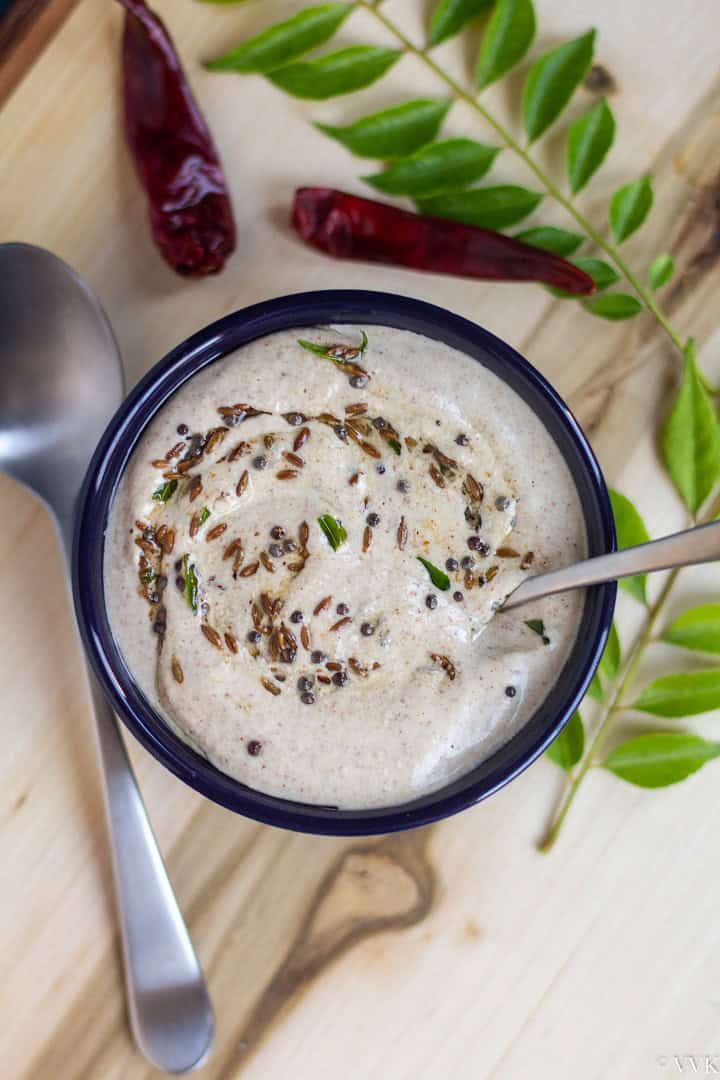
This peanut chutney (In Tamil, we call it as verkadalai chutney) is a perfect side for your idli, dosa, uttapam, and many other tiffin items. And it’s a fantastic sandwich spread as well! Check out how to make this chutney with detailed step-wise pictures.
Jump to:
Indian cuisine is known for its lip-smacking chutneys, and this peanut chutney is one of them. If you are new to Indian cuisine, these chutneys are more like sauces and dips. We usually serve this as a side dish. This popular South Indian peanut chutney is an excellent accompaniment for idli, dosa, (learn how to make coconut chutney, which is a popular side for idli and dosa)and other snack items like pakoras, etc.
I learned this recipe from my husband, who, in turn, learned from his Telugu friend. Today, I am sharing my version of the Andhra style Palli chutney. Palli means peanuts or groundnuts in Telugu. While there are many variations to the Andhra style chutney, here is mine without garlic and coconut but with shallots. Please check the recipe notes for the variations.
Now let’s get straight into the details.
Ingredient required
Peanuts – The star ingredient of this recipe. I have answered if we should roast them and use skinned ones in the FAQ section. Please check.
Green chili and shallots – Adjust the green chilies to taste and shallots are optional. But it does add nice flavor.
Tamarind paste – I have used my homemade tamarind paste. You can use a small betel-nut sized tamarind too.
To temper – I have used coconut oil, but use oil of your choice. We need mustard seeds, cumin seeds, asafoetida and curry leaves.
Apart from these ingredients, we also need salt and water. Please check the recipe card for measurements and also check the variations section for alternatives.
Frequently asked questions
Well, these days, you find roasted peanuts in the store. You can very well use that for this recipe, but make sure to buy the unsalted ones. Buying roasted peanuts saves a few minutes, but it is not mandatory to buy roasted peanuts. I went with raw or unroasted peanuts for this chutney. Even if you buy roasted ones, I would recommend roasting them for at least a minute to bring that crispiness
It’s up to your choice. When I learned this recipe initially, I used to try it with skinned peanuts, and even if I buy with skin, after roasting, I try to remove the skin. It was quite a task, and one fine morning when I was running late, I made this chutney with skin, and we all loved it. No drastic change, and from that point, I always use peanuts with skin, which I did for this recipe as well.
With skin or without skin and roasted or unroasted, you can make this peanut chutney in less than 20 minutes. :-) If you use skinned peanuts, the chutney will be white, whereas if you use peanuts with skin, the chutney will be light brown.

The shelf life of the chutney
This peanut chutney without coconut stays pretty well in the refrigerator for up to five days. The chutney thickens when we refrigerate. So thin it down with water as required. This chutney freezes pretty well. So you can make it a part of your weekend meal planning.
This peanut chutney is naturally vegan.
Peanut chutney recipe with detailed step-wise pictures-
- Heat a pan and add a tsp of coconut oil. When the oil is hot, add the peanuts, green chilies broken into small pieces and shallots cut into halves.
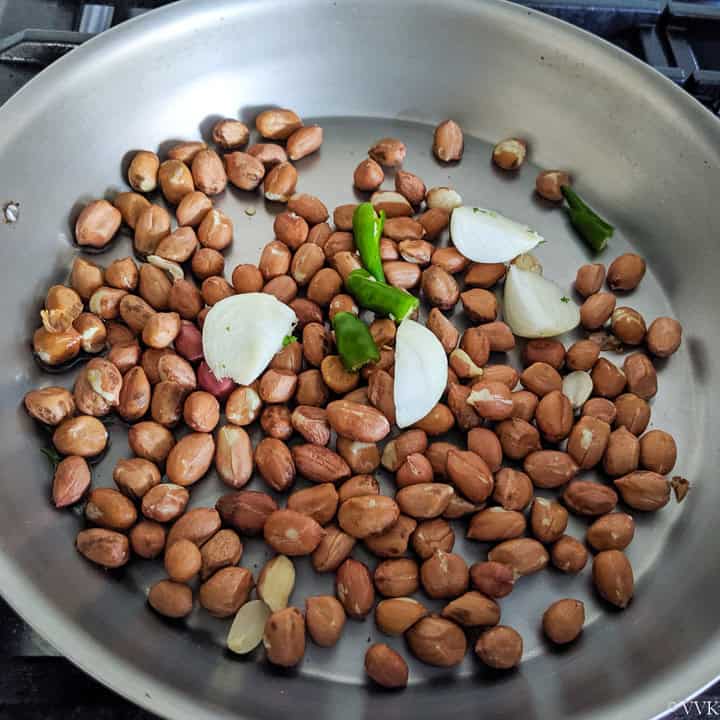
- Saute until the peanuts turn crisp or skin turns brownish-black. It usually takes about 4 to 5 minutes over medium heat.

- Turn off the heat and let the peanuts cool completely.
- Now transfer the roasted peanuts along with the chilies and shallots to a mixer jar and add the tamarind paste and salt. Without adding any water, pulse it into a coarse mixture.
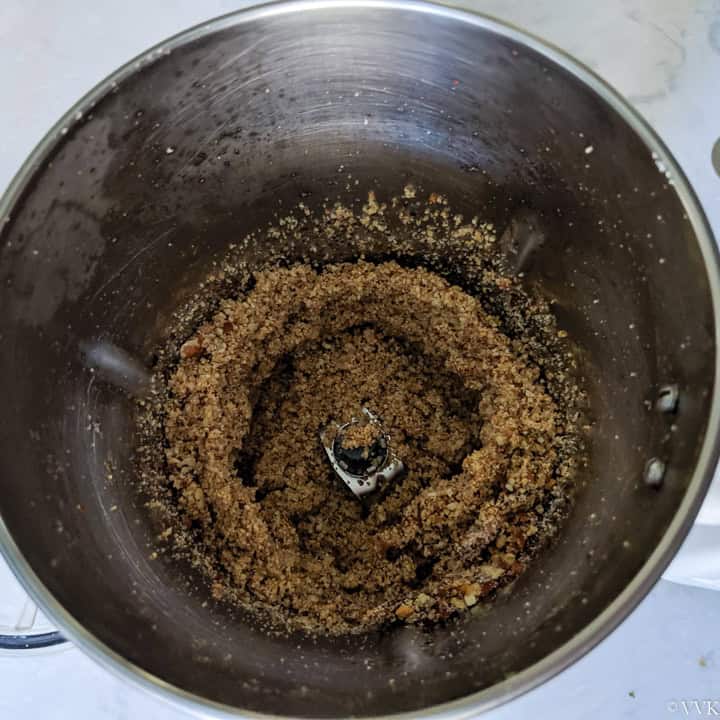
- Add ½ cup of water and grind it, and this is how it looks. Check for salt and add if required.
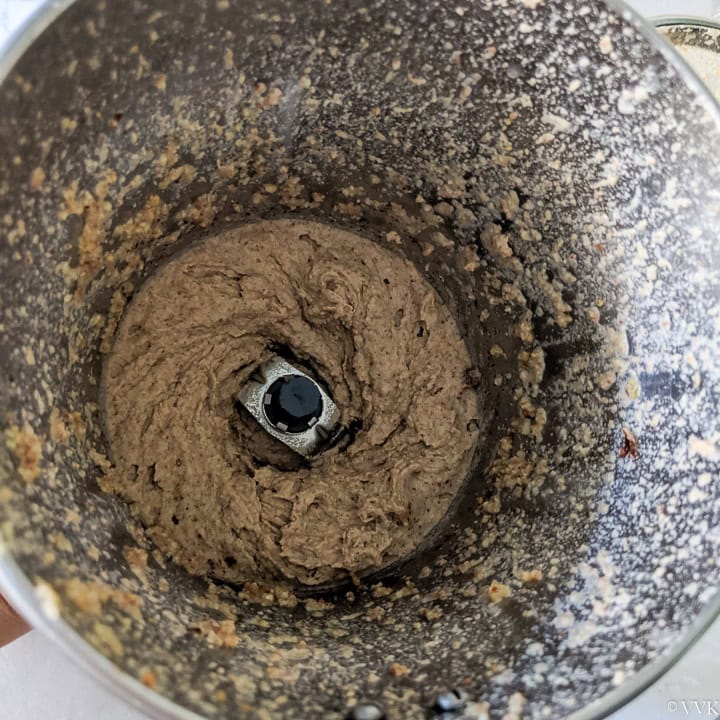
- Now add ½ more cup of water and grind it into a smooth mixture.
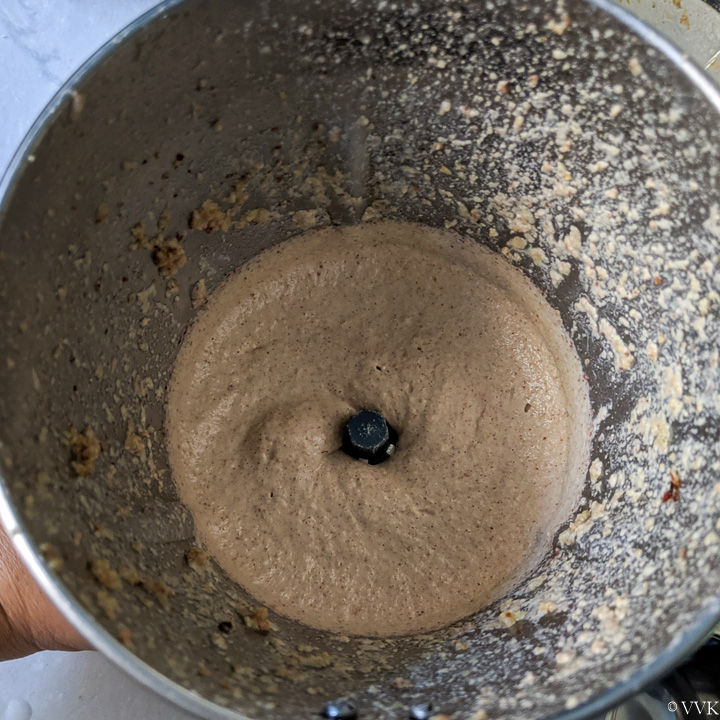
- Transfer this to the bowl and rinse the mixer jar with ¼ cup of water and add it to the chutney. I used 1.25 cups of water in total. You can adjust it according to your consistency preference.

- In a separate tempering pan, add the remaining 1 tsp of coconut oil. When the oil is hot, add the mustard seeds, cumin seeds, curry leaves, and asafoetida. When mustard seeds splutter, turn off the heat and add it to the chutney.
- That’s it. Delicious peanut chutney is ready. Serve it with idli, dosa, or with appetizers.
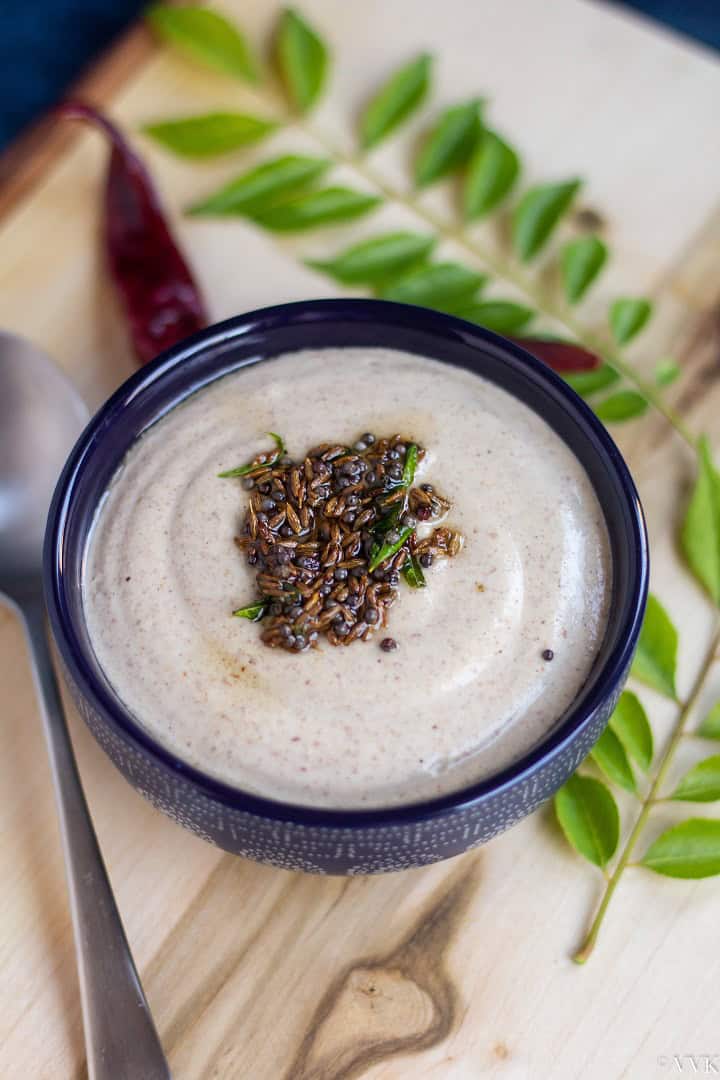
Recipe Notes
- As always, adjust salt and spice according to your preference.
- Instead of cumin seeds, you can add urad dal and chana dal while tempering.
- Asafoetida and curry leaves are optional. You can use cilantro to garnish as well.
- As mentioned in the post, you can use roasted peanuts without skin. But roast it for a minute to bring out the taste.
- Also, make sure to use good quality peanuts. The rancid ones will ruin the chutney.
- The chutney thickens as it stays. So before serving, if required, thin down the chutney by adding room-temperature water.
Variations
- Instead of shallots, you can include two cloves of garlic or both shallots and garlic.
- If you are using tamarind flesh/pulp, you can use a small marble-sized one and saute it along with the peanuts so that it softens. Or you can soak it in ½ cup of water and extract the juice and use the tamarind water while grinding.
- You can also use dried red chilies instead of green ones. And you can add ¼ to ½ cup of coconut as well for more flavor. But the shelf life is comparatively less.
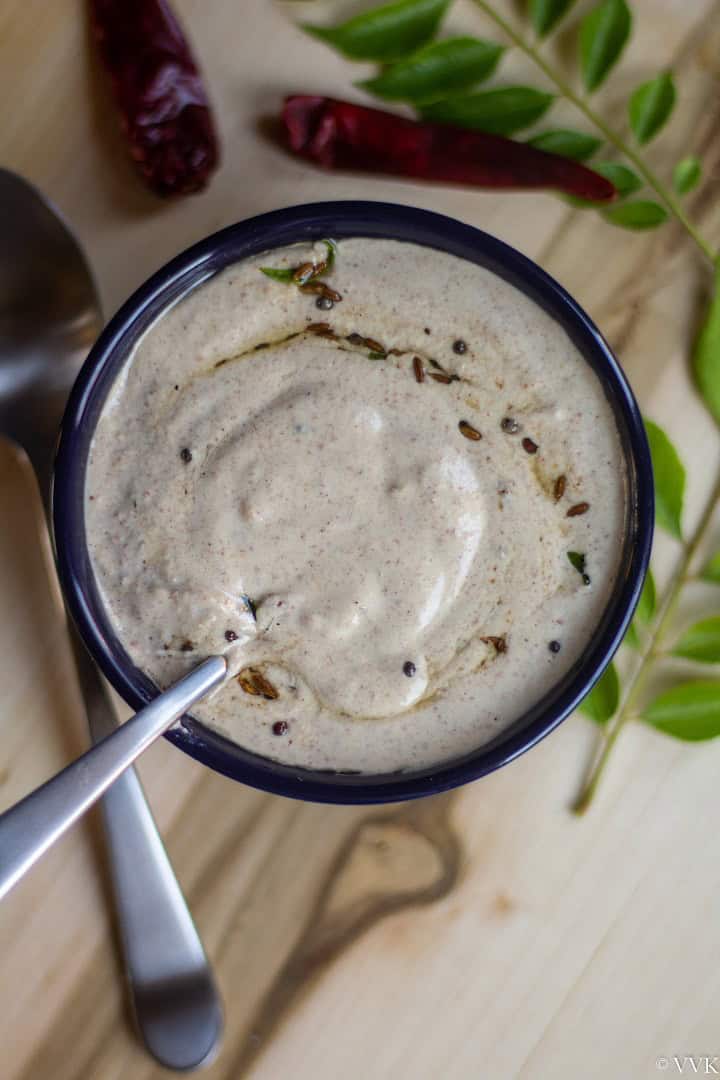
Other chutney recipes
If you like this peanut chutney and looking for other chutney recipes, then check these out.
PS: Follow me on Instagram or join my Facebook Group for more gardening and recipe updates. If you try this peanut chutney recipe, please don’t forget to comment and rate this recipe. If you have any questions, please leave a comment, and I will get to it asap. Make sure to follow me on my Pinterest for more healthy and delicious ideas!
📖 Recipe
Peanut Chutney Recipe | Groundnut Chutney | Indian Style Peanut Dip
Equipment
- Fry pan and mixer jar
Ingredients
Measurement Details: 1 cup=240ml;1 tsp=5ml;1 tbsp=15ml;
- 1 cup peanuts raw (see notes/post about skin)
- 2 green chili or to taste
- 2 shallots optional
- 1 tsp tamarind paste if using tamarind flesh, then use a small gooseberry or marble size
- 1.25 cup water
- 1 tsp salt heaped or to taste
- 2 tsp coconut oil divided
- ½ tsp mustard seeds
- 1 tsp cumin seeds
- ⅛ tsp asafoetida skip for gluten-free chutney
- 2 to 3 curry leaves optional
Instructions
- Heat a pan and add a tsp of coconut oil. When the oil is hot, add the peanuts, green chilies broken into small pieces and shallots cut into halves.
- Saute until the peanuts turn crisp or skin turns brownish-black. It usually takes about 4 to 5 minutes over medium heat.
- Turn off the heat and let the peanuts cool completely.
- Now transfer the roasted peanuts along with the chilies and shallots to a mixer jar and add the tamarind paste and salt. Without adding any water, pulse it into a coarse mixture.
- Add ½ cup of water and grind it, and this is how it looks. Check for salt and add if required.
- Now add ½ more cup of water and grind it into a smooth mixture.
- Transfer this to the bowl and rinse the mixer jar with ¼ cup of water and add it to the chutney. I used 1.25 cups of water in total. You can adjust it according to your consistency preference.
- In a separate tempering pan, add the remaining 1 tsp of coconut oil. When the oil is hot, add the mustard seeds, cumin seeds, curry leaves, and asafoetida. When mustard seeds splutter, turn off the heat and add it to the chutney.
- That’s it. Delicious peanut chutney is ready. Serve it with idli, dosa, or with appetizers.
Notes
- As always, adjust salt and spice according to your preference.
- Instead of cumin seeds, you can add urad dal and chana dal while tempering.
- Asafoetida and curry leaves are optional. You can use cilantro to garnish as well.
- As mentioned in the post, you can use roasted peanuts without skin. But roast it for a minute to bring out the taste.
- Also, make sure to use good quality peanuts. The rancid ones will ruin the chutney.
- The chutney thickens as it stays. So before serving, if required, thin down the chutney by adding room-temperature water.
- Variations–
- Instead of shallots, you can include two cloves of garlic or both shallots and garlic.
- If you are using tamarind flesh/pulp, you can use a small marble-sized one and saute it along with the peanuts so that it softens. Or you can soak it in ½ cup of water and extract the juice and use the tamarind water while grinding.
- You can also use dried red chilies instead of green ones. And you can add ¼ to ½ cup of coconut as well for more flavor. But the shelf life is comparatively less.
Nutrition
I am not a nutritionist. The nutritional information is provided as a courtesy and is an estimate only. It varies depending upon the product types or brands.




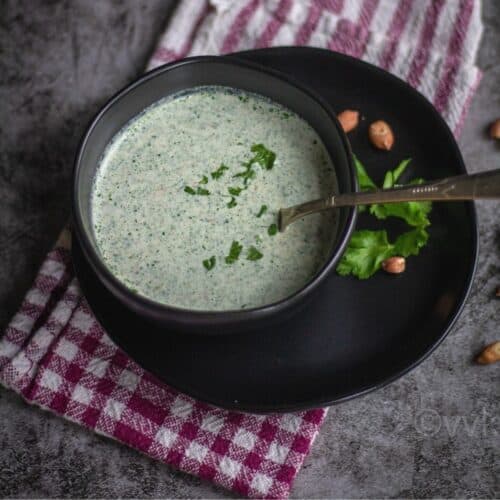
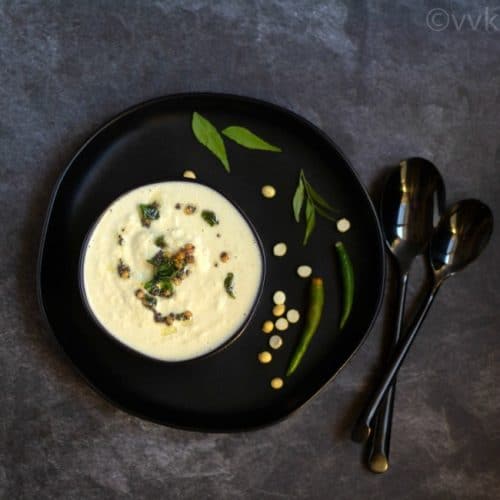



Leave a Reply